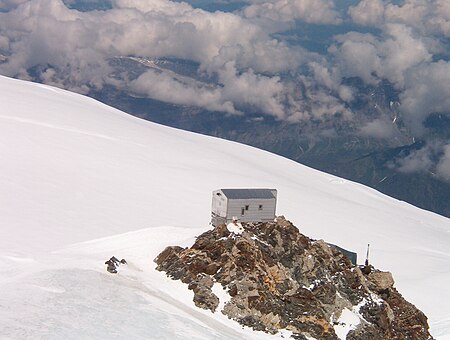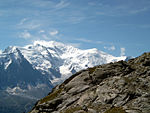The Mont Blanc massif (French: Massif du Mont-Blanc; Italian: Massiccio del Monte Bianco) is a mountain range in the Alps, located mostly in France and Italy, but also straddling Switzerland at its northeastern end. It contains eleven major independent summits, each over 4,000 metres (13,123 ft) in height. It is named after Mont Blanc (4,808 metres (15,774 ft)), the highest point in western Europe and the European Union. Because of its considerable overall altitude, a large proportion of the massif is covered by glaciers, which include the Mer de Glace and the Miage Glacier – the longest glaciers in France and Italy, respectively.
The massif forms a watershed between the vast catchments of the rivers Rhône and Po, and a tripoint between France, Italy and Switzerland; it also marks the border between two climate regions by separating the northern and western Alps from the southern Alps. The mountains of the massif consist mostly of granite and gneiss rocks and at high altitudes the vegetation is an arctic-alpine flora.
The valleys that delimit the massif were used as communication routes by the Romans until they left around the 5th century AD. The region remained of some military importance through to the mid-20th century. A peasant farming economy operated within these valleys for many centuries until the glaciers and mountains were "discovered" by the outside world in the 18th century. Word of these impressive sights began to spread, and Mont Blanc was first climbed in 1786, marking the start of the sport of mountaineering. The region is now a major tourist destination, drawing in over six million visitors per year. It provides a wide range of opportunities for outdoor recreation and activities such as sight-seeing, hiking, rock climbing, mountaineering and skiing. Around one hundred people a year die across its mountains and, occasionally, bodies have been lost and entombed in its glaciers for decades.
Access into the mountains is facilitated by cable cars, mountain railways and mountain huts which offer overnight refuge to climbers and skiers. The long-distance Tour du Mont Blanc hiking trail circumnavigates the whole massif in an 11-day trek of 170 kilometres (110 mi). The Mont Blanc Tunnel connects the French town of Chamonix on the northern side with the Italian town of Courmayeur in the south. The high mountains have provided many opportunities for scientific research, including neutrino measurements within the tunnel and impact of climate change on its highest slopes. Recent rises in average temperatures have led to significant glacial retreat across the massif and an awareness of the need for better environmental protection, including a call for World Heritage Site status.










